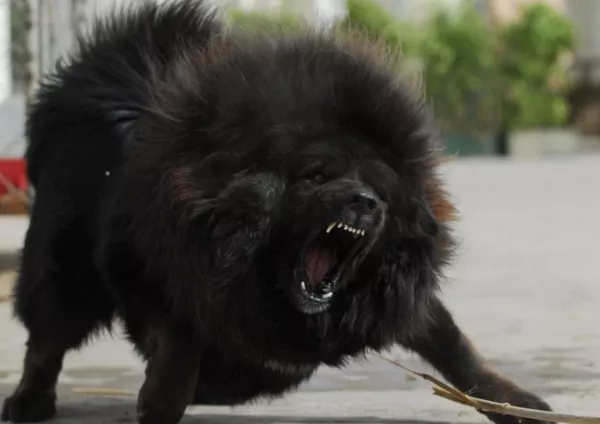The majestic Tibetan Mastiff, with its distinctive appearance and imposing demeanor, is a breed that has captured the fascination of dog enthusiasts around the world. Recognizing a Tibetan Mastiff among other breeds requires an understanding of their unique characteristics and traits. In this article, we will delve into the key features that help you identify a Tibetan Mastiff.
1. Impressive Size and Build
One of the most striking aspects of a Tibetan Mastiff is its impressive size. These dogs are large and sturdy, with a well-muscled build that exudes strength and power. Male Tibetan Mastiffs typically stand around 26 to 28 inches tall at the shoulder, while females range from 24 to 26 inches. Their weight can vary significantly, often ranging from 75 to 160 pounds or more, depending on factors like gender and genetics.
2. Thick Double Coat
The Tibetan Mastiff’s double coat is designed to withstand the harsh climate of the Himalayas, where the breed originated. The outer coat is coarse and straight, while the undercoat is dense and soft, providing insulation against both cold and heat. Their coat comes in a variety of colors, including shades of black, brown, gray, and gold, often with markings on the chest and tail. The coat’s length and thickness can vary, but the luxurious mane around the neck is a characteristic feature.
3. Profound Facial Expression
The Tibetan Mastiff’s face is one of its most distinguishing features. With a large head and well-developed jaw muscles, the breed possesses a distinctively noble and serious expression. Their eyes are deep-set and expressive, often displaying a watchful and alert demeanor. Eye color can vary, but shades of brown are most common. Their ears are pendant and v-shaped, hanging close to the head.
4. Strong and Well-Balanced Structure
Tibetan Mastiffs boast a strong and well-balanced body structure that contributes to their commanding presence. Their neck is powerful and muscular, leading to a deep and broad chest. The breed’s back is straight and level, with a strong loin and slightly sloping croup. Their tail is bushy and heavily feathered, curling over their back when at rest, which adds to their regal appearance.
5. Aloof but Loyal Temperament
While physical characteristics play a significant role in identifying Tibetan Mastiffs, understanding their temperament is equally important. These dogs are known for their aloof nature, which is a result of their protective instincts. Tibetan Mastiffs are loyal and devoted to their families, often forming strong bonds with them. They are wary of strangers and can exhibit a reserved behavior, making socialization and training crucial from an early age.
Conclusion
Identifying a Tibetan Mastiff involves recognizing their distinct size, coat, facial expression, body structure, and temperament. These unique features combine to create a breed that is both visually impressive and deeply loyal. Whether you’re considering adding a Tibetan Mastiff to your family or simply appreciating their beauty, understanding these key characteristics will enable you to recognize this magnificent breed wherever you encounter it.
FAQs about Tibetan Mastiff:
1. Do Tibetan Mastiffs make good guard dogs?
Yes, Tibetan Mastiffs have a strong guarding instinct and are naturally protective of their families and property. Their imposing appearance and cautious behavior toward strangers make them effective guard dogs.
2. How can I identify a Tibetan Mastiff based on its size?
Tibetan Mastiffs are notably large dogs, with males standing around 26 to 28 inches tall at the shoulder and females ranging from 24 to 26 inches. Their weight can vary significantly, often ranging from 75 to 160 pounds or more, depending on factors like gender and genetics.
3. What is unique about the Tibetan Mastiff’s coat?
The Tibetan Mastiff’s coat is double-layered, with a coarse outer coat and a dense, soft undercoat. This unique coat helps them withstand the harsh Himalayan climate. Their coat comes in various colors, often with distinct markings, and can range in length and thickness.
4. How can I recognize a Tibetan Mastiff’s facial expression?
The Tibetan Mastiff’s face is characterized by a large head and a serious, noble expression. They have deep-set, expressive eyes that display an alert demeanor. Their ears are pendant and v-shaped, hanging close to the head, contributing to their distinctive look.
5. What is the typical temperament of a Tibetan Mastiff?
Tibetan Mastiffs are known for their protective and loyal nature. They can be aloof with strangers and have a reserved demeanor, which is a result of their protective instincts. They form strong bonds with their families and are devoted to them.
6. Is socialization important for Tibetan Mastiffs?
Yes, socialization is crucial for Tibetan Mastiffs. Since they can be wary of strangers, early socialization helps them become more comfortable in various situations and environments. Proper socialization also contributes to a well-rounded and confident dog.
7. Are Tibetan Mastiffs suitable for families with children?
Tibetan Mastiffs can be great family companions, but due to their protective nature, it’s important to introduce them to children and teach both the dog and the children how to interact safely and respectfully. Supervision is essential when they’re around young children.
8. Do Tibetan Mastiffs require a lot of grooming?
Yes, Tibetan Mastiffs have a double coat that requires regular grooming. Brushing helps prevent matting, removes loose fur, and keeps their coat healthy. During shedding seasons, more frequent grooming may be necessary to manage their shedding.
9. Are Tibetan Mastiffs easy to train?
Tibetan Mastiffs are intelligent dogs, but they can also be independent and stubborn. Early and consistent training is essential, focusing on positive reinforcement methods. Due to their protective nature, training should include proper socialization and obedience commands.


